A brief history of artificial lighting at Ely Cathedral
 Photography by James BillingsLight Perception, specialist lighting consultants for historic buildings, has recently been appointed as lighting consultants to Ely Cathedral and, having designed a new scheme for the octagon – featured on the front cover of our latest issue – is now designing a new scheme for the interior.
Photography by James BillingsLight Perception, specialist lighting consultants for historic buildings, has recently been appointed as lighting consultants to Ely Cathedral and, having designed a new scheme for the octagon – featured on the front cover of our latest issue – is now designing a new scheme for the interior.
This article, by director Bruce Kirk, describes some of the earlier artificial lighting schemes in the cathedral and explains what lessons have been learned from understanding the work of past designers.
When Ely Cathedral was built a thousand years ago it would not have been expected that the building would be widely used outside the hours of daylight. Lighting technology had advanced as far as a combination of large central fireplaces, candles, rush lights (rush stalks soaked in melted fats) and flaming torches (timbers bound with rags soaked in fats). Such light sources would probably only have been used for reading or writing by the community, rather than for general illumination of the building – except perhaps for important feast days and festivals.
It was not until the 1800s that lighting technology developed gas and paraffin alternatives to the dirty, smoky and rather smelly combustion of oils and fats.
Gas lighting found its way into churches and cathedrals from around the 1840s. By the 1820s, gaslight cost around 75% less than oil lamps or candles, accelerating its development and deployment. By 1859, gas lighting was to be found all over Britain, supplied by around a thousand gas works which had sprung up to meet the demand. There was of course no National Grid. In Ely there were two main firms competing to supply the new fuels to the city. Nevertheless, the uptake was relatively slow; but we do know there was gas in the cathedral.
In 2021 the Cathedral Chapter set out a very carefully considered brief for a new lighting scheme, which is an essential starting point for such a complex undertaking.
Another factor that strongly influences the design development of this type of project is the extent to which lessons can be learned from the work of previous designers. In developing the scheme design, we took a long look at the current and earlier lighting schemes, and are indebted to the cathedral, and especially the Honorary Archivist who kindly provided a summary of the history of electric light in the cathedral and provided a series of images of earlier lighting schemes.
 Fig. 1
Fig. 1
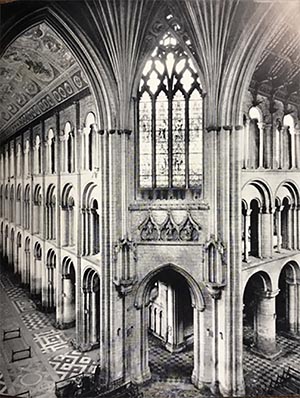 Fig. 2
Fig. 2  Fig. 3 While electric lighting at Ely is well documented, there is less information on the cathedral’s gas lighting. There is a grainy image of gas lighting in the Lady Chapel (Fig 1 above) and there remain two gasoliers (long since electrified) in the sanctuary. Aside from this there are minutes of meetings encouraging the removal of the ‘dirty gas system’ and its replacement by a new electric lighting scheme in the 1930s.
Fig. 3 While electric lighting at Ely is well documented, there is less information on the cathedral’s gas lighting. There is a grainy image of gas lighting in the Lady Chapel (Fig 1 above) and there remain two gasoliers (long since electrified) in the sanctuary. Aside from this there are minutes of meetings encouraging the removal of the ‘dirty gas system’ and its replacement by a new electric lighting scheme in the 1930s.
The first references to electric lighting show wall lights (Fig 2 left) which seem to have been positioned at a consistent height throughout the head of the nave, octagon and quire. There are helpful references in the minutes to ‘lighting the people rather than the building’ which describe the work. We also know that the Friends donated £80 in 1961 for the installation of high floodlighting in the quire to supplement the wall lights (Fig 3 right).
The 1930s wall light installation did not extend to the middle or west end of the nave. An image from 1973 (Fig 4 below) shows additional lights suspended across the nave that was certainly contrary to the philosophy of lighting the people not the building.
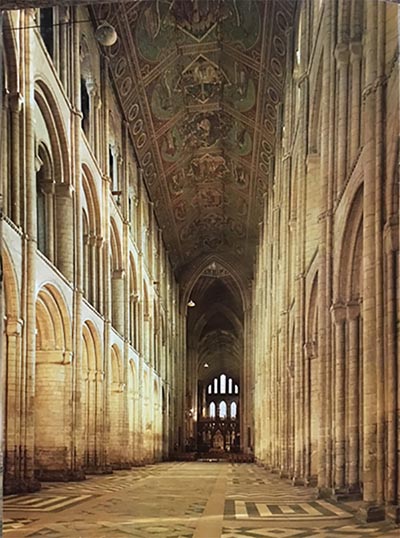 Fig. 4
Fig. 4
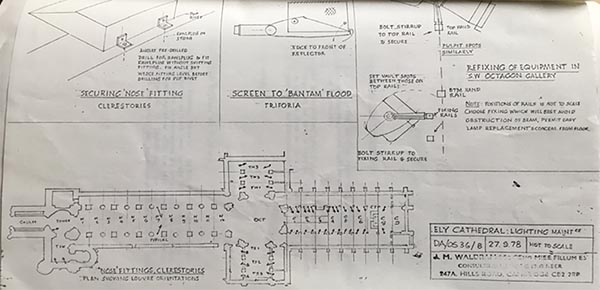 Fig. 5
Fig. 5  Fig. 6 So we see three separate sets of electric light fittings, added progressively over some 40 years, each being a reaction to a specific need rather than part of what we would now refer to as a ‘holistic’ scheme for the whole cathedral interior.
Fig. 6 So we see three separate sets of electric light fittings, added progressively over some 40 years, each being a reaction to a specific need rather than part of what we would now refer to as a ‘holistic’ scheme for the whole cathedral interior.
That approach changed dramatically in the late 1970s when J M Waldron was commissioned to design a more complete scheme for the cathedral. He devised a complete installation, combining theatrical and bespoke fittings for the triforium and clerestory levels (Fig 5 left) there are sketches of some of the fittings (Fig 6) and a wonderful perspective sketch highlighting the intended focusing of some of the lighting for the nave, octagon, transepts and quire.
 Fig. 7 Photographs also show part of the completed installation in the nave and quire (Fig 7 left).
Fig. 7 Photographs also show part of the completed installation in the nave and quire (Fig 7 left).
The Walden scheme lasted just less than twenty years, being replaced in the mid-1990s by the current design, which used the best of the equipment available at the time. The designer was Graham Phoenix who had previously worked at Peterborough Cathedral and carried out other work in Southwell Minster and the Lady Chapel at Hereford.
 Fig. 8 The choice of luminaires in the early 1990s was quite limited by today’s standards. While there was some choice of smaller, low voltage spotlights for use in smaller areas such as the aisles and chapels, there were far fewer options for the type of higher-powered floodlights and spotlights needed at triforium level to illuminate the larger spaces such as the nave, octagon and quire. The high level fittings are large scale exterior floodlights with relatively short life mains-voltage halogen lamps. They are heavy and have large brackets of a much more industrial design.
Fig. 8 The choice of luminaires in the early 1990s was quite limited by today’s standards. While there was some choice of smaller, low voltage spotlights for use in smaller areas such as the aisles and chapels, there were far fewer options for the type of higher-powered floodlights and spotlights needed at triforium level to illuminate the larger spaces such as the nave, octagon and quire. The high level fittings are large scale exterior floodlights with relatively short life mains-voltage halogen lamps. They are heavy and have large brackets of a much more industrial design.
For many of these spotlights to be able to light their intended targets they must ‘look over’ the triforium ledges and be cantilevered from mounting points fitted further back on the triforium (Fig 8 right). They are mounted on complex theatre-style scaffolding structures that allow for long bars to reach from behind the arcading to the front edge of the triforium.
Comparative illustrations of the new scheme proposals compared to those of the 1990s show the differences in physical sizes of fittings (Fig 9 1996 & Fig 10 2021).
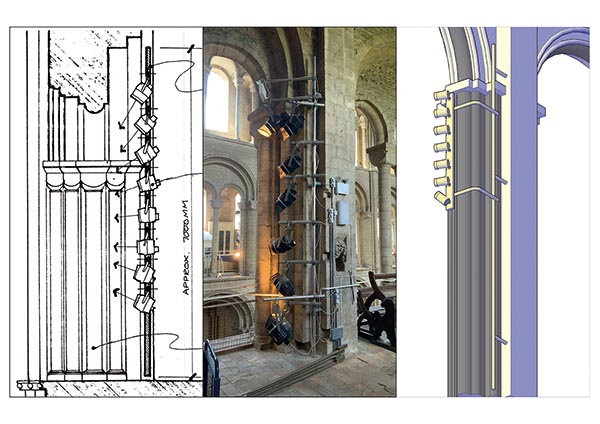 Fig. 9
Fig. 9 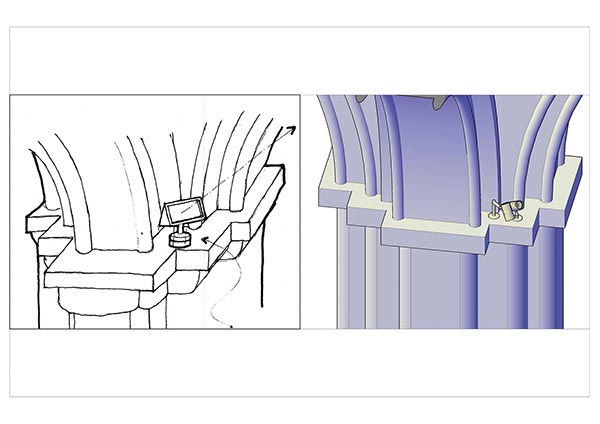 Fig. 10 The lessons learned from past schemes tell us that the repeated surface-mounted lights of the 1930s installation – almost down at eye level – would have been quite a distraction. Despite providing localised light for reading, they would not have illuminated the centre of the nave or octagon: hence the need for the high-level spotlighting added in 1961.
Fig. 10 The lessons learned from past schemes tell us that the repeated surface-mounted lights of the 1930s installation – almost down at eye level – would have been quite a distraction. Despite providing localised light for reading, they would not have illuminated the centre of the nave or octagon: hence the need for the high-level spotlighting added in 1961.
We also see that the floodlighting of the 1970s would have been a significant improvement at the time, but was very much limited by both the light sources available and the quality of the optics or reflectors used.
The spotlighting of the 1990s was a very significant step forward in the application of applied lighting design. Many of the principles applied are still valid today, but the result can be very significantly improved upon by deploying the more sophisticated luminaires and controls available to designers today.
Finally, in designing a new scheme for a cathedral, it is also vital to understand the way in which these important buildings need to evolve to meet current and future expectations. An obvious example of changing requirements is shown on the front cover image of the octagon, with the new lighting easily reprogrammed to portray the Ukrainian flag.
• For further information call 01494 899440 or visit the website at www.lightperceptions.co.uk.
Figs 1 - 10 courtesy of Ely Cathedral















